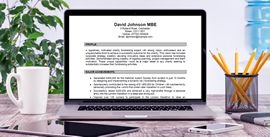How to Write a Functional CV
A Functional CV may help if you're want to change career. In the current economic climate, it's especially hard to find employment, particularly if you've been redundant. It's possible that you're having to apply for jobs that aren't in line with the positions you've previously held. This means finding ways to adapt your existing experience and skills to fit the requirements of a prospective employer.
Shifting your job hunting strategy slightly means you may also need to change the way you write your CV. What worked before may not work as well now - you're up against fiercer competition than ever and need to work harder to get noticed.
If you need help with your CV, the professional CV writers at Bradley CVs can produce a CV for you that generates the interviews you crave.
Why Might You Use a Functional CV?
If you're having to change career direction in order to gain a job, a Functional CV format might suit you. The advantage is that it helps to highlight the skills and abilities you have that are relevant to the vacancy, highlighting the strengths of your application before the employer notices that your recent jobs were in a slightly different line.
A Functional CV, also known as a 'Skills-Based CV', focuses the employer's mind on what you're able to offer, rather than what jobs you've held. Remember, though, that a functional CV will not help you to gain a job that you're not qualified for. All it does is reorganise the information on your CV to draw attention to different points.
Use a functional CV if you:
- Aim to change career track.
- Are returning to a former career area.
- Have had a long series of short contract jobs - especially technical.
- Have tricky gaps in your employment history due to redundancy, unemployment, illness, etc.
- Are overqualified for the vacancies you're applying for.
- Are a mature applicant and want to divert attention from your long career history.
- Are leaving the army, navy or air force.
What's your Work Situation?
It goes without saying that you are looking for a job. However, just wanting a job - any job - isn't enough to get you one. An employer still needs to be persuaded that you have the experience and skills required for their vacancy, and also that you really want that particular job. Even if you're feeling desperate, you have to be clear about what you want to do, what you're capable of doing and where your strongest chances of gaining employment lie.
Only once this is clear can you write a professional CV that will be truly effective in gaining you an interview. That is its sole purpose - to get you short-listed for interview, where you then have to perform well enough to gain a job offer.
When you come to list your skills on your functional CV, you can group them into categories and choose headings for each category. This is one of the ways in which you can angle the content towards a particular kind of job, or even one vacancy in particular. To do so effectively, you need to asses yourself and the kind of positions you're applying for.
The Sections in Your Functional CV
The section headings in a Functional CV typically look like this (although again, there is variation to be found):
- Statement or Profile.
- Skills areas.
- Training.
- Education / qualifications.
- Experience (job titles, employer names and dates only).
- Other Information.
- Personal details.
Writing Your Statement or Profile for a Functional CV
At the top of your Functional CV is your name and contact details. Below this comes three to four lines of information that sum up your application by saying what you're offering an employer.
This comprises three or at the most four sentences in which you highlight your most relevant skills, achievements and qualities.
It's a chance for you to create a focus for the CV and create a positive impression from the very start.
Your statement should present you in the third person (as if you're writing about somebody else), stating your professional area of work, a couple of points of key experience, and your main professional experience and skills.
If you haven't enough to list for the job in question, you can also introduce one or two transferable skills and personal attributes.
Listing Your Skills on a Functional CV
It's important that you list all your skills and abilities on a Functional CV. You need to think about what you actually did, rather than what you were originally expected to do when appointed.
That's why it's a good idea to take your time reflecting, rather than just reading old job descriptions. Include:
- Technical skills that you learned at work (e.g. administrative skills, IT skills).
- Transferable skills that you can use in any position (e.g. interpersonal skills, communication skills, staff supervision) - these may not be work-based, but can come from voluntary or community work, running clubs, organising events, etc.
- Professional skills (e.g. marketing, accounting or book keeping qualifications, etc.)
- Personal qualities (e.g. friendly, outgoing and courteous, working independently, etc.)
Out of your list, decide which is relevant to the vacancies you're applying for. This means you need to read job descriptions for every vacancy - you might need to change the order of your lists, or include/exclude particular points.
Choosing Your Skills Headings For Your Functional CV
With your lists established, you need to group the skills under headings on your Functional CV. These are usually subdivisions of professional areas. For example, if you have held marketing positions, then your category headings might be Copywriting, Account Management, Advertising, Research, etc. Beneath these you would list individual skills areas - e.g. under Copywriting, you might have advertisement copy, press releases, website content, etc.
Here are some possible headings: Administration Skills, Human Resources Skills, Accounting Skills, Management Skills, Supervisory Skills, Planning Skills, Communication Skills, Technical Skills, Teaching Skills, Creative Skills. There are many more you can select.
If you're not sure, look at a major jobs' listing website and take a look at the Advanced Search tool. You will sometimes be able to see professional areas, then beneath them, more targeted functions.
You can confirm which of these will be useful on your Functional CV by looking at job descriptions and seeing how employers are grouping the skills and experience they're looking for. CVs posted online will also help you with ideas.
Your skills need to be presented either in a table or as short sentences with bullet points. Use bullet points that highlight particular skills, thus killing two birds with one stone.
Listing Your Training, Education and/or Qualifications
Depending on how much information you have to include on your Functional CV, you can have one section called Training and Qualifications, or separate sections comprising variation of these three headings. Again, you need only include relevant information, rather than all information.
With training, only describe the course content if it's relevant or fails to make sense without it. For certificated courses, you can include the title of the certificate, the awarding body and the date you received it. With short one or two-day courses that you were sent on at work, just include the general training areas.
With education, you only need to include the most recent academic qualification. This might be a degree, higher qualifications or school level qualifications. If your have highly relevant studies, include a line or two to highlight a work placement, a dissertation, or other vocational point.
Listing Your Experience For a Functional CV
The way in which you present your career history and work background is very different to the way you may have done it on a Chronological CVs. For a start, it's on the second page of your Functional CV. Next, it's basically a list of your positions, the employers and inclusive dates, with no further information about what your responsibilities or duties in each role.
As well as inclusive dates for the full period of your employment, you can add further dates alongside the different roles you held with that employer (if applicable). This is a way of showing that you changed jobs within the same organisation, or that you were promoted.
Some sample CVs you see online won't even include dates for employment. However, it's sensible to do so, due to the fact that many employers wish to see them and it'll therefore improve your chances of gaining an interview.
Begin with your most recent employer and work backwards. Include locations if you feel that your previous employers were too local to be recognised in a different geographical area.
Listing Other Information on a Functional CV
You don't have to include this section, but it's useful to do so if there's other information you feel ought to be in your Functional CV.
Be careful not to include information the employer doesn't need to see, such as details of your age or nationality.
It's more valuable to list association memberships and information that you're sure will contribute to a positive impression - e.g. highly impressive sporting achievements, highly esteemed unpaid roles, etc.
Keep Your Functional CV Flexible
The whole point of a Functional CV is that it can be adapted to suit your special circumstances. If your background is problematic and you feel it may be causing problems with your job search, then this format may help you to start gaining interviews. Never forget that your functional CV has to be extremely strong, otherwise it may work against you by obscuring your background and making employers suspicious rather than interested.
Take your time researching and preparing the qualities of a dynamic functional CV, so that yours is a powerful document. Always research by reading job descriptions and you'll stand a far better chance of doing this. Be ready to spend time adapting this CV for each position, rearranging the skills groups and even introducing or removing categories.
Other pages you might want to view:
- Need a first-class CV? Our CV writers can really improve your CV, which means you will win more interviews.
- CV Examples
- Free CV Review
- How to Write a Good CV
- CV Format
- CV Personal Statement
- Skills Based CV





